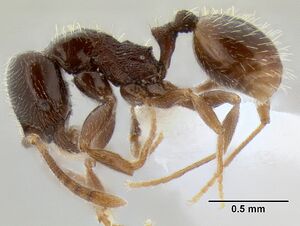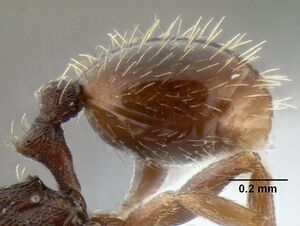Stenamma andersoni
| Stenamma andersoni | |
|---|---|

| |
| Scientific classification | |
| Kingdom: | Animalia |
| Phylum: | Arthropoda |
| Class: | Insecta |
| Order: | Hymenoptera |
| Family: | Formicidae |
| Subfamily: | Myrmicinae |
| Tribe: | Stenammini |
| Genus: | Stenamma |
| Species: | S. andersoni |
| Binomial name | |
| Stenamma andersoni Branstetter, 2013 | |
This species is only known from a two workers collected from a single Berlese sample. The ants were found in sifted leaf litter from a cloud forest at 990 m elevation.
Identification
Branstetter (2013) - Integument brown to red-brown (note that observed speci- mens are old, fresh specimens probably darker); small-sized species (see HL, ML, PrW below); anterior clypeal margin undulating, forming 2–4 small blunt teeth; basal margin of mandible sinuous, with a shallow basal depression, but without a basal tooth; head and pronotum mostly smooth and shiny; promesonotum in profile with relatively sharp transitions between anterior and dorsal faces, and between pronotum and mesonotum; pilosity on gastral tergites forming a layer of stout suberect setae, and a sparse layer of decumbent setae; eye of moderate size (EL 0.08–0.09, PSL 0.08–0.10), oval-shaped, with 5 ommatidia at greatest diameter; propodeal spines tuberculate (PSL 0.08–0.10, PSI 1.2–1.3); frontal lobes of moderate width (FLD 0.12–0.13, FLI 23– 24), not obscuring torular lobes in full-face view.
Stenamma andersoni should be easy to separate from similar species by its smooth head and pronotum, unique pronotum shape, and thickened gastral setae.
Keys including this Species
Distribution
Southern Mexico (Oaxaca). Known only from the type locality.
Latitudinal Distribution Pattern
Latitudinal Range: 16.22° to 16.22°.
| North Temperate |
North Subtropical |
Tropical | South Subtropical |
South Temperate |
- Source: AntMaps
Distribution based on Regional Taxon Lists
Neotropical Region: Mexico (type locality).
Distribution based on AntMaps
Distribution based on AntWeb specimens
Check data from AntWeb
Countries Occupied
| Number of countries occupied by this species based on AntWiki Regional Taxon Lists. In general, fewer countries occupied indicates a narrower range, while more countries indicates a more widespread species. |

|
Estimated Abundance
| Relative abundance based on number of AntMaps records per species (this species within the purple bar). Fewer records (to the left) indicates a less abundant/encountered species while more records (to the right) indicates more abundant/encountered species. |

|
Biology
Castes
Only known from the worker caste.
Worker
Images from AntWeb
          
| |
| Worker. Specimen code casent0604603. Photographer Michael Branstetter, uploaded by Default Group. | Owned by FMNH. |
Nomenclature
The following information is derived from Barry Bolton's Online Catalogue of the Ants of the World.
- andersoni. Stenamma andersoni Branstetter, 2013: 49, fig. 51 (w.) MEXICO (Oaxaca).
- Type-material: holotype worker, 1 paratype worker.
- Type-locality: holotype Mexico: Oaxaca, 10.9 km. N Candelaria, 990 m., 12.vii.1987, RSA87-15 (R.S. Anderson); paratype with same data.
- Type-depositories: USNM (holotype); UNAM (paratype).
- Distribution: Mexico.
Unless otherwise noted the text for the remainder of this section is reported from the publication that includes the original description.
Description
Worker
(2 measured) HL 0.60–0.63 (0.63), HW 0.50–0.55 (0.55), FLD 0.12–0.13 (0.13), PCW 0.03 (0.03), SL 0.49–0.52 (0.52), EL 0.08–0.09 (0.09), ACL 0.47–0.49 (0.49), ML 0.76–0.81 (0.81), PrW 0.36–0.39 (0.39), PSL 0.08–0.10 (0.10), SDL 0.06–0.08 (0.08), PL 0.27–0.29 (0.29), PH 0.16–0.19 (0.19), PW 0.12– 0.13 (0.13), PPL 0.15–0.16 (0.16), PPH 0.14–0.16 (0.16), PPW 0.16–0.17 (0.17), MFL 0.54–0.57 (0.57), MTL 0.42–0.45 (0.45), CI 85–88 (85), SI 95–98 (95), REL 16–17 (17), FLI 23–24 (23), PSI 1.2–1.3 (1.2), PI 53–54 (53), MFI 93–97 (97), ACI1 68 (68), ACI2 94–96 (94).
Small-sized species; general body color brown to red-brown (note observed specimens are older, fresh material almost certainly darker), with appendages lighter, brown to yellow-brown at extremities; setae golden; mandible with 6 teeth; basal margin of mandible sinuous, with a shallow basal depression, but no basal tooth; mandible mostly smooth, except for some conspicuous basal striae, and scattered piligerous punctae; anterior clypeal margin undulating, forming 2–4 small blunt teeth; median lobe of clypeus smooth, without noticeable carinulae, apex of lobe with a short transverse carinulae, remainder of clypeus smooth and shiny; posterior extension of clypeus between antennal insertions somewhat narrow (PCW 0.03), with sides subparallel; frontal lobes of moderate width (FLD 0.12–0.13, FLI 23–24), not obscuring torular lobes in full- face view; head roughly oval-shaped (CI 85–88), posterior margin with a slight median depression; eye of moderate size (EL 0.08–0.09, REL 16–17), oval-shaped, with 5 ommatidia at greatest diameter; face almost completely smooth and shiny, except for a few carinulae around frontal lobes and on genae, and scattered piligerous punctae; scape of moderate length (SI 95–98), not quite reaching posterior margin when laid back; scape surface mostly smooth, with faint striations, and scattered piligerous punctae; flagellum with a distinct 4–segmented antennal club; all of pronotum and most of mesonotal dorsum smooth and shiny, anepisternum rugose, katepisternum punctate, side of propodeum mostly punctate, with a few rugulae, dorsum and declivity of propodeum with transverse carinulae; promesonotum in profile low-domed, roughly symmetrical, with relatively sharp (and distinctive) transitions between anterior and dorsal faces, and between pronotum and mesonotum; metanotal groove of well-demarcated, of moderate width and depth; propodeal spines tuberculate (PSL 0.08–0.10, PSI 1.2– 1.3); petiole appearing of moderate length (PL/HW 0.53–0.54); petiolar node in profile of moderate height (PH/PL 0.60–0.65), roughly symmetrical, with anterior and posterior faces almost equal in length, node dorsum rounded, but somewhat narrow, pointing vertically; postpetiole in profile subspherical, slightly smaller than petiolar node (PPH/PH 0.84–0.86); petiole and postpetiole mostly lightly punctate, with anterior faces of nodes smooth; gaster mostly smooth and shiny, with scattered piligerous punctae; most of body dorsum with thickened standing pilosity; pilosity on gastral tergites forming a layer of stout suberect setae, and a sparse layer of decumbent setae; setae on scapes dense, decumbent to appressed; setae on legs mostly appressed, with a few suberect to subdecumbent setae on femoral venters and coxae.
Type Material
Holotype worker. MÉXICO, Oaxaca: 10.9km N. Candelaria, [ca. 16.220°N, 95.891°W], 990m, 12 Jul 1987, cloud forest, ex sifted leaf litter (R. S. Anderson, collection RSA87-15) USNM, specimen CASENT0604603. Paratype: same data as holotype 1w, UNAM, CASENT0604602.
Etymology
Stenamma andersoni is named after the distinguished weevilologist Robert S. Anderson, who's indefatiguable collecting efforts and intense focus on leaf litter arthropods are responsible for uncovering this species.
References
- Branstetter, M. G. 2012. Origin and diversification of the cryptic ant genus Stenamma Westwood (Hymenoptera: Formicidae), inferred from multilocus molecular data, biogeography and natural history. Systematic Entomology 37:478-496. doi:10.1111/j.1365-3113.2012.00624.x.
- Branstetter, M.G. 2013. Revision of the Middle American clade of the ant genus Stenamma Westwood (Hymenoptera, Formicidae, Myrmicinae). ZooKeys 295, 1–277. doi:10.3897/zookeys.295.4905


